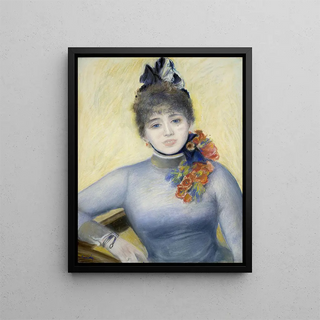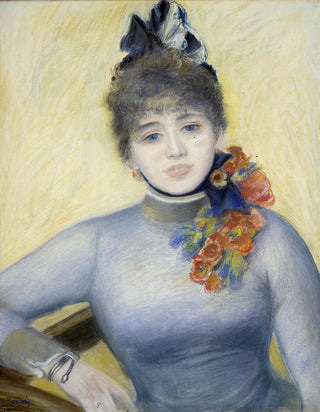Art print | Caroline Rémy - Pierre-Auguste Renoir


View from behind

Frame (optional)
Caroline Rémy - Pierre-Auguste Renoir – Captivating Introduction
In the rich and vibrant universe of Impressionism, the artwork "Caroline Rémy" by Pierre-Auguste Renoir stands out for its delicacy and expressiveness. Created in 1896, this painting captures a moment of life filled with grace and serenity, highlighting the timeless beauty of its model. Renoir, an undisputed master of light and color, manages to convey a palpable emotion through the subtle features of Caroline Rémy's face, an iconic figure of his era. The art print of this piece allows not only for appreciation of the artist's technical virtuosity but also for immersing oneself in the vibrant atmosphere of the late 19th century, where each brushstroke seems to tell a story.
Style and uniqueness of the work
The uniqueness of "Caroline Rémy" lies in how Renoir plays with light and shadow to bring his subject to life. The warm and soft hues, typical of his style, envelop Caroline's face with a particular glow, emphasizing her delicate features and introspective gaze. The artist does not merely depict a human figure; he seeks to capture the very essence of his model, her personality, and her soul. The blurred, almost abstract background creates an intimate atmosphere, allowing the viewer to focus on the beauty of Caroline while evoking the surrounding nature. This approach, which diverges from academic conventions, reflects Renoir's desire to celebrate life in all its forms, with a sensitivity that is uniquely his own.
The artist and his influence
Pierre-Auguste Renoir, a major figure of Impressionism, knew how to leave his mark on his era through his innovative approach to painting. Born in 1841, he was initially influenced by classical masters before turning to a style that emphasizes light and color. Renoir always sought to depict the pleasures of life, from festive scenes to tender moments, including portraits imbued with humanity. His influence is felt not only through his own works but also through many artists who followed in his footsteps.

Matte finish

View from behind

Frame (optional)
Caroline Rémy - Pierre-Auguste Renoir – Captivating Introduction
In the rich and vibrant universe of Impressionism, the artwork "Caroline Rémy" by Pierre-Auguste Renoir stands out for its delicacy and expressiveness. Created in 1896, this painting captures a moment of life filled with grace and serenity, highlighting the timeless beauty of its model. Renoir, an undisputed master of light and color, manages to convey a palpable emotion through the subtle features of Caroline Rémy's face, an iconic figure of his era. The art print of this piece allows not only for appreciation of the artist's technical virtuosity but also for immersing oneself in the vibrant atmosphere of the late 19th century, where each brushstroke seems to tell a story.
Style and uniqueness of the work
The uniqueness of "Caroline Rémy" lies in how Renoir plays with light and shadow to bring his subject to life. The warm and soft hues, typical of his style, envelop Caroline's face with a particular glow, emphasizing her delicate features and introspective gaze. The artist does not merely depict a human figure; he seeks to capture the very essence of his model, her personality, and her soul. The blurred, almost abstract background creates an intimate atmosphere, allowing the viewer to focus on the beauty of Caroline while evoking the surrounding nature. This approach, which diverges from academic conventions, reflects Renoir's desire to celebrate life in all its forms, with a sensitivity that is uniquely his own.
The artist and his influence
Pierre-Auguste Renoir, a major figure of Impressionism, knew how to leave his mark on his era through his innovative approach to painting. Born in 1841, he was initially influenced by classical masters before turning to a style that emphasizes light and color. Renoir always sought to depict the pleasures of life, from festive scenes to tender moments, including portraits imbued with humanity. His influence is felt not only through his own works but also through many artists who followed in his footsteps.






